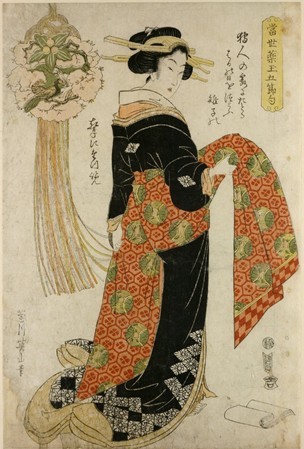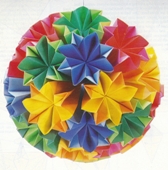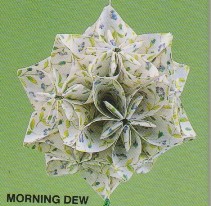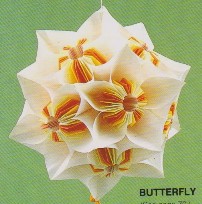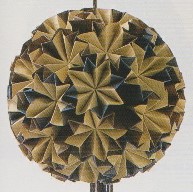| The Public Paperfolding History Project
Last updated 12/11/2024 xx |
|||||||
| Kusudama | |||||||
| This
page attempts to record what is known about the origin
and history of the Kusudama. Please contact me if you
know any of this information is incorrect or if you have
any other information that should be added. Thank you. Kusudama were originally bags of cloth containing herbs. At some point - and I do not know when - the word kusudama also began to be used to describe hanging balls of flowers made from folded paper, which were often glued or sewn together. This is said to be one of the roots of modular origami but hard information from historical sources to confirm this is currently lacking. It should be noted that the term kusudama is frequently nowadays used as a word to describe any modular ball or star design. In my opinion, however, the term should be reserved for those modular designs which represent balls of flowers of leaves. ********** 1002 The 'Pillow Book of Sei Shonagon', (accessed in the translation by Ivan Morris) which was completed in 1002, contains a reference to herbal balls:
*** Note 64 explains:
********** 1867 A traditional kusudama of this kind is pictured in this undated print 'Tosei Kusudama Go-sekku' by the artist Kikugawa Eizan (1787-1867) which is in the collection of the British Museum.
********** 1954 'Atari Origami Geijuitsu' by Akira Yoshizawa, which was published by Origami Geijutsu Sha in 1954, contains a photograph of a kusudama. The design is not diagrammed or mentioned in the text and it is not clear whether it is a glued multi-piece or a modular design.
********** 1987 Eric Kenneway's 'Complete Origami', first published in 1987, contains diagrams for the kusudama pictured below. According to the text, diagrams for this design first appeared in the Nippon Origami Association's journal 'Origami' in April 1978.
********** 1990 'Kusudama: Ball Origami' by Makoto Yamaguchi was published in English by Shufunotomo Co Ltd in Japan in 1990. The book contains two kinds of designs, those which are genuinely kusudama and are held together with glue or thread, and those which should more properly be called modular sculptures since they do not resemble balls of herbs or flowers in any way, and which are mostly self-integrating.
********** |
|||||||


